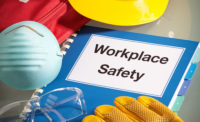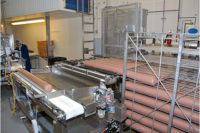A host of perils await workers at meat and poultry processing facilities.
High noise levels, dangerous equipment, slippery floors, harmful chemicals and musculoskeletal issues are causing illness and injury rates in the meat packaging industry to be 2.5 times higher than the national average, according to the U.S. Department of Labor’s Bureau of Labor Statistics (BLS).
Serious injuries requiring work restrictions or days away from work, meanwhile, are more than three times higher in meatpacking than U.S. industries as a whole, the BLS reports.
“Musculoskeletal disorders comprise a large part of these serious injuries and continue to be common among meat packing workers,” according to the U.S. Department of Labor’s Occupational Safety and Health Administration (OSHA). “In addition, meat packing workers can be exposed to biological hazards associated with handling live animals or exposures to feces and blood which can increase their risk for many diseases.”
Skin infections, flu, gastrointestinal infections, pneumonia, meningitis and sepsis (blood infection) are among the possible health hazards from exposure to biological agents during slaughter, when handling freshly slaughtered meat and from ill animals, OSHA reports.
Safety measures can include providing workers with appropriate personal protective equipment (PPE), such as waterproof gloves, facemasks and goggles, OSHA reports. Companies also should train employees on biological hazards, recognition of symptoms, use of PPE and hand hygiene practices. An intent to minimize such risks already is resulting in safety upgrades across the meat and poultry spectrum.
Safety is in the spotlight
Tyson Foods Inc. has about 500 health and safety professionals developing and implementing worker safety measures including training procedures, safety audits, ergonomic enhancements and health care methodologies, says Greg Spencer, Tyson’s senior vice president of health and safety.
The Springdale, Ark.-based producer of chicken, beef and pork had a 22 percent decrease in worker injury and illness incidents in fiscal year 2017 versus the previous year, and exceeded the company’s goal of a 15 percent decline, he says.
“Evolving from a compliance-based to a behavior-based health and safety approach is critical to success,” Spencer says, adding that Tyson is more closely tracking, measuring and analyzing workers’ actions and responses to occurrences.
After an incident, for instance, the processor collects data and studies the root cause of the action in order to lower subsequent risks, he says.
“We are not looking at safety as an event that happens and to which we need to react, but as part of the process in which we conduct everyday operations,” Spencer says.
Tyson, meanwhile, is expanding its We Care health and safety communications program to all of its poultry plants this year. The initiative, which launched in 2015, is intended to enhance worker awareness and implementation of safety methods, to motivate employees to promptly report all workplace injuries and illnesses and to create executive safety councils.
As part of We Care, Tyson in fiscal year 2017 began developing pilot health care programs for occupational illness prevention. Spencer says. The measures are in addition to the company’s existing in-house occupational health services that are supported by Tyson’s nursing department. Tyson is evaluating the performance of the pilot programs, he says.
The processor also is collaborating with the United Food and Commercial Workers International Union (UFCW) to make workplace safety improvements to a dozen Tyson poultry plants.
The effort, which was previously confined to beef and pork operations, will include plant safety audits by management and union representatives, ergonomic improvements and the creation of safety committees that enable frontline workers and their union to regularly meet with plant management on safety matters. Tyson also is empowering frontline workers to halt production if they detect safety or ergonomic issues.
Take an aggressive approach
Being proactive in developing strategies for greater worker safety is essential for reducing threats in meat and poultry plants, says Zack Levenson, chief operating officer of Golden West Food Group, a Vernon, Calif.-based manufacturer of raw and cooked proteins, including Certified Angus Beef selections.
“You have to go beyond measuring incidents and evaluate workers’ risks prior to the work commencing,” he says. “Communicating goals and objectives is vital to the success of the strategy, along with ensuring that the proper job-specific training is executed through supervisor and management feedback. Developing a continual feedback loop for process and training improvement is key.”
It also is crucial to create worker buy-in by enabling employees to participate in the creation and execution of safety measures, Levenson says.
“Treat them as an asset of information for developing procedures,” he says. “Creating a culture of ownership will lead to much better results.”
Because processing environments are constantly evolving with influxes of new employees and machinery and changing workspace dynamics, Levenson says it is essential for processors to consistently uphold their safety standards.
“That is why the cultural, employee-driven approach is so important,” he says.
Workers, meanwhile, can play a variety of roles in creating safety and health guidelines. Land O’Frost — a Lansing, Ill.-based supplier of lunch meats, sausages and franks — for instance has its hourly employees head the safety committees at all processing facilities, says Justin Kobler, Land O’Frost vice president of manufacturing.
“This gives employees a sense of ownership in the process and empowerment to help identify the ways in which to make the environment safer,” he says.
Land O’Frost’s Lansing plant was a recipient of the 2018 Award of Honor worker safety award from the Washington, D.C.-based North American Meat Institute (NAMI).
A mix of methods
The processor uses a variety of vehicles to train employees on safety measures, including PowerPoint tools and videos, says Shawn Lynn, Land O’Frost director of environmental health and safety. In addition, workers get hands-on instruction for lockout-tagout procedures, personal protective equipment use, electrical safety and handling ammonia refrigerants.
“A robust orientation program provides ample time to discuss safety measures to ensure new employees understand the safety requirements and expectations,” he says.
Land O’Frost also frequently launches worker meetings with a discussion of safety opportunities and areas of concern, Employees are encouraged to submit safety suggestions after monitoring plant and department conditions and to report injury close calls, Lynn says.
Lynn notes, meanwhile, the greatest risk to safety often arises from workers being proactive in their jobs.
“Someone sees something that needs to be done and incidents may happen out of the positive intent to do the right thing quickly,” he says. Land O’Frost works hard “to encourage that same recognition and urgency in acting, but stresses the importance of stepping back to ensure that the right things get done in the right way. It may not be the quickest way, but it will be done safely,” he says.
To help prevent workers from becoming complacent, Land O’Frost frequently updates its safety postings and instructional materials, and plants often rotate their areas of focus “to keep things fresh with associates,” Lynn says.
Plant audits also are intended to locate and prevent safety shortcomings. Annual audits focus on firefighting techniques, respiratory protection, heat stress awareness, lab safety and electrical safety.
Biannual audits include incident investigation, first aid and CPR training, lockout-tagout, personal protective equipment, knife safety training, film roll handling and natural gas safety.
In addition, line operators perform daily audits of their lines along with a pre-startup audit and an every-two-hour audit. Other audits identify slip, trip and fall hazards; monitor the performance of maintenance employees during voltage testing; and to ensure chemicals are labeled correctly and that chemical safety data sheets are on site, Lynn says.
“We’re trying to address issues before they become incidents,” says Michael Bartikoski, Land O’Frost senior vice president of operations.
Land O’Frost and its insurance carrier are beta testing safety perception surveys to gage employees’ attitudes toward the safety department and address areas of concern, Lynn says.
Solicit employee safety submissions
Providing an environment in which employees are comfortable suggesting safer practices, meanwhile, is a key worker safety element at Omaha Steaks International, an Omaha-based meat and poultry supplier, says Beth Fye, corporate safety and risk manager.
The company has internal programs in which it solicits employee input, and workers also participate in plant safety inspections, she says.
“Worker safety previously was primarily a top-down approach,” she notes. “But we’ve come to realize that employees have great buy-in to programs and solutions by getting more involved.”
Such involvement led two workers to recently design, and the company to fabricate, a machine guard with better ergonomics, Fye says.
Yet, even with greater worker participation, it still often is a challenge to get all employees to focus on safety procedures throughout a shift as “minds wander,” she says.
To maintain interest, Omaha Steaks is trying to make safety considerations a fun experience by having employees partake in contests that are based on television game shows. These games include Wheel of Safety, Safety Family Feud and Safety Jeopardy. The company also offers safety-related crossword puzzles and word searches, Fye says.
Omaha Steaks, which received a NAMI worker safety Award of Merit and Award of Commendation for activity at two of its Omaha processing plants, seeks to gain further insights on possible safety techniques by studying other companies’ methods, having staffers attend relevant conferences, and from internal brainstorming sessions, she says.
Because traditional safety training methods often do not resonate well with Millennials, Fye says the company is investigating ways to enhance engagement, such as by disseminating data through smart phones and tablets.
The safety needs of older and aging workers also is a consideration, she says, noting Omaha Steaks is studying how to reduce physical stresses, which could include incorporating more pallet and film lifts and adding additional conveyors.
The company uses outside physical therapists to determine the physical demands and risks of each job and has workers participate in stretching programs at the start of each shift, Fye says. NP





Report Abusive Comment